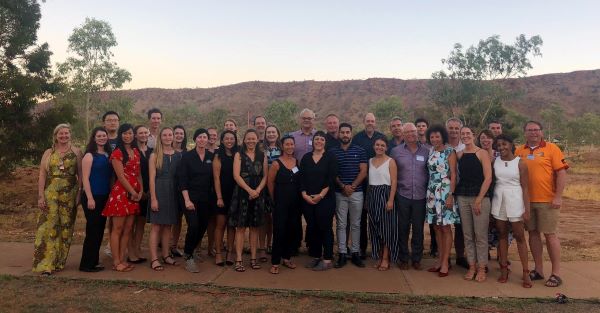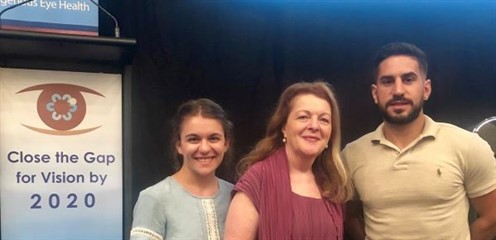1:30min

By Sarah Davies
Optometry Australia Policy and Advocacy Manager
More than 35 optometrists attended a recent Close the Gap for Vision conference in the Northern Territory.
Indigenous Eye Health (IEH), the University of Melbourne and Aboriginal Medical Services Alliance Northern Territory (AMSANT) co-hosted the Close the Gap for Vision by 2020: Strengthen & Sustain National Conference 2019 at the Alice Springs Convention Centre on March 14 and 15.
Optometry Australia is a supporting partner of the conference with Vision 2020 Australia and the Royal Australian and New Zealand College of Ophthalmologists.
Mitchell Anjou, optometrist and Academic Specialist in Indigenous Eye Health at the University of Melbourne said he was delighted with the growing involvement of optometrists in close the gap for vision initiatives.
‘This is certainly an exciting opportunity for optometry and optometrists. We know that we need to provide more eye examinations for Indigenous Australians and working with community members and organisations to deliver on this goal is critical to close the gap for vision,’ he said.
The Close the Gap for Vision by 2020 conference provided delegates with the opportunity to highlight the very real advances being made in Aboriginal and Torres Strait eye health. It explored successes and opportunities to strengthen eye care and initiatives and challenges to sustain progress towards the goal of equitable eye care by 2020.
It was a wonderful opportunity to connect with people involved in all aspects of Aboriginal and Torres Strait Islander eye care – from Aboriginal Community Controlled Health Organisations, other Indigenous and mainstream health services and non-government organisations, to professional bodies and government departments, as well as, most importantly, Aboriginal and Torres Strait Islander Australians.
Representatives from Optometry Australia included CEO Lyn Brodie, Member Support and Optometry Advancement – General Manager Skye Cappuccio, myself and Optometry Victoria’s Member Services and Policy Manager Michelle Marven.
The optometry profession has a key role to play in strengthening and sustaining efforts to close the gap in vision outcomes for Aboriginal and Torres Strait Islander people, and seeing so many optometry colleagues in attendance showed how committed we are to this important cause.

Optometry Australia CEO Lyn Brodie with bursary recipients Stephanie Callisto and Jose Estevez.
Optometry Australia also provided bursaries for two early career optometrists with a growing interest in Aboriginal and Torres Strait Islander health to attend – Stephanie Callisto and Jose Estevez.
‘The conference was a brilliant way to meet and draw inspiration from like-minded people who are truly passionate about their roles in Indigenous eye health,’ Stephanie said. ‘I hope to use the knowledge gained through the workshops and presentations throughout the rest of my career.’
Jose said: ‘The conference was very different from the usual eye conferences I have attended, being very interactive and with many great personal and community stories shared. I drew a lot of inspiration for my own work not just in Indigenous eye health, but health more broadly.’
Key themes included delegate agreement that self-determination is core to efforts to close the gap in vision, as is effectively integrating optometry in primary health care.
Delegates also raised workforce challenges, particularly regarding attracting, supporting and retaining Aboriginal and Torres Strait Islander optometrists, and working with all eye health professionals to support the provision of culturally safe services in their practice settings.
Optometry Australia also presented on its Optometry 2040 project, asking key questions:
- In moving towards models of consumer-centric care, driven by ‘partici-patients’, what can optometry learn from Aboriginal Community Controlled Health Organisations?
- What are the risks or opportunities for technology-led health care in Aboriginal and Torres Strait Islander people to access eye health care?
- How can optometry’s scope of practice best evolve to support best practice eye care for Aboriginal and Torres Strait Islander people?
Valuable insights gained from conference delegates will help guide implementation of findings from Optometry 2040.
Tagged as: Indigenous eye health